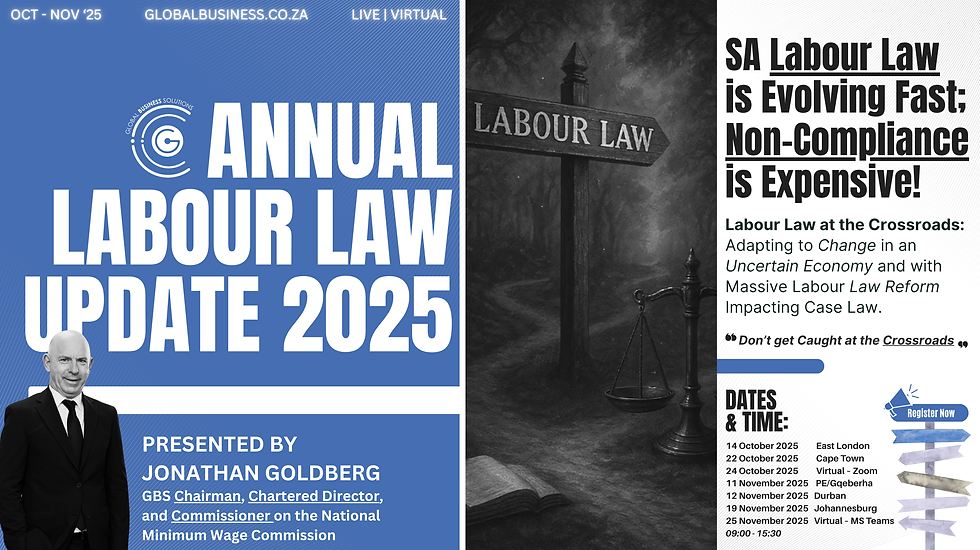Van Wyk Post-Ruling: Navigating Compliance, Risk Management, and Implementation of South Africa’s New Parental Leave Framework
- Sue Singh

- Nov 6
- 4 min read

Overview
The Van Wyk judgment has surfaced a spectrum of legal and operational complexities for employers, including the critical question of whether to sustain paid parental leave benefits amid the shifting statutory landscape.
This evolving jurisprudential environment necessitates that employers undertake a rigorous, considered review and recalibration of their parental leave policies.
By conscientiously balancing statutory compliance obligations, business continuity imperatives, and the welfare of employees, organisations should endeavour to establish parental leave benefits frameworks that are simultaneously equitable, supportive, and operationally sustainable.
Introduction
The Constitutional Court’s judgment in Van Wyk and Others v Minister of Employment and Labour has ushered in a landmark transformation of the statutory parental leave regime under the Basic Conditions of Employment Act (BCEA), while significantly impacting corresponding benefits under the Unemployment Insurance Act (UIA).
In this ruling, the Court declared specific provisions of the BCEA and UIA constitutionally invalid, identifying entrenched discriminatory treatment predicated on gender and parental status, particularly concerning disparate leave durations and benefit entitlements.
Must be deemed a party to the parental relationship under the Children’s Act
To afford Parliament adequate time to rectify the statutory framework, the Court suspended the declaration of invalidity for a period of 36 months, while simultaneously mandating interim amendments to the BCEA effective 3 October 2025.
This decision presents immediate and profound challenges for employers, spanning legal compliance mandates and operational execution As the regulatory landscape rapidly evolves, organisations are compelled to undertake a strategic risk assessments and reassessment of their parental leave policies.
A detailed analysis of the ruling can be found on our publications and guidelines provided on the Van Wyk and parental leave series.
Updated Leave Provisions Post-Ruling
The Court’s interim orders significantly revise parental leave entitlements under the BCEA, effectively consolidating maternity, parental, adoption, and commissioning parental leave into a singular parental leave category during the transitional period.

While the judgment advances shared caregiving responsibilities, acknowledging fathers, adoptive parents, and commissioning parents alike, including in same-sex relationships, it also precipitates operational and financial complexities for employers.
Notably, organisations may need to curtail previously more generous paid benefits, primarily extended to birth mothers, to align with the interim provisions and avoid claims of discrimination.
Financial and Operational Considerations
Historically, many employers, particularly larger enterprises, have voluntarily afforded paid maternity benefits as a talent attraction and retention strategy, supplementing the comparatively modest UIF provisions.
Post-2020 BCEA amendments introduced statutory parental, adoption, and commissioning leave categories, with some employers extending paid provisions accordingly often at shorter durations than maternity leave.
The ruling mandates equalisation of benefits across all parents to prevent discrimination claims which inevitably could substantially increase costs, as non-birth parents, such as fathers may claim leave multiple times annually or over extended careers, unlike biological limitations for mothers.
Extended absences from paid leave could further strain operational efficiency and productivity.
UIF benefits remain unchanged in the interim, capped at modest levels and durations (e.g., 10 days for fathers), despite broader leave entitlements. This mismatch may prompt employers to reconsider paid benefits entirely as an initial cost-control measures, resulting in scaling back paid leave as an immediate reaction is a common response. There are strategic alternatives that may preserve certain benefits without excessive financial strain.
Strategies for Designing Paid Parental Benefits
Employers should begin by assessing whether there are objectively defensible grounds for differentiating paid parental benefits by gender or parental status, having regard to the nature of their industry, workforce composition, and operational requirements. Such distinctions must be lawfully justifiable to withstand potential discrimination challenges.
Where employers currently offer paid maternity or parental leave, potential approaches may include:
Ring-fencing existing employees, while amending the maternity or parental leave policy to limit or remove paid benefits for future employees.
Undertaking consultation in terms of section 189 or 189A of the Labour Relations Act, where the removal or material alteration of paid benefits constitutes a change to terms and conditions of employment.
Implementing a capped benefit structure, by calculating an average annual maternity payment based on the preceding two to three years and applying this as a maximum allocation. Benefits could then be administered on a first-come, first-served basis each year, with any additional leave taken as unpaid once available funds are exhausted.
*** Further strategic insights and practical solutions will be shared during our upcoming ALLU and Parental Leave webinars.
While these strategies may limit access to paid benefits, they do not relieve employers of their obligation to provide statutory unpaid parental or maternity leave. Properly managed, certain measures may assist in mitigating productivity disruptions by discouraging unnecessary or extended absences where portions of leave are unpaid.
Final Thoughts
The Van Wyk ruling introduces significant practical hurdles for employers, more so for employers that have established enhanced leave benefits. In this changing legal context, a proactive review of policies is essential.
Organisations can achieve sustainable outcomes by harmonising regulatory requirements, business priorities, and employee support, ultimately fostering parental leave systems that are inclusive, and economically feasible.
For customised risk assessments , policy formulation and compliance assurance in the evolving parental leave landscape, please contact our specialist team at Global Business Solutions.
Join us at the Annual Labour Law Update. This year's theme is Labour Law at the Crossroads: Adapting to Change in an Uncertain Economy and with Massive Labour Law Reform Impacting Case Law. What you'll gain:
Master the Digital Transformation of Labour Law in 2025
200+ Labour Law Cases Unpacked by Jonathan Goldberg
Critical Updates on Upcoming Legislation & NEDLAC Amendments
Navigate Workplace Challenges from the Digital Era to Discrimination Laws

View our upcoming events: Upcoming Events, like Landmark Judgment: Equal Parental Leave for All Parents, Managing Absenteeism in the Workplace, and #ALLU2025.
*All workshops are offered as customised in-house training that can be presented virtually or on-site.
"Global Business Solutions (GBS)—Your Partner in Strategic HR Compliance"










Comments